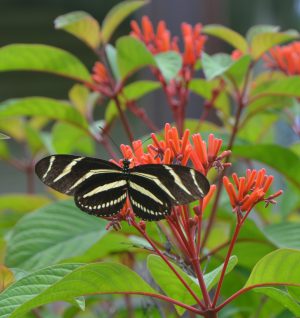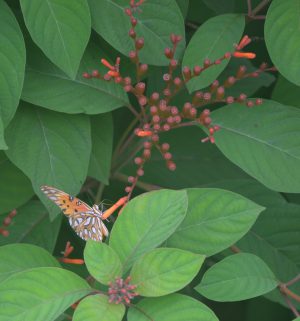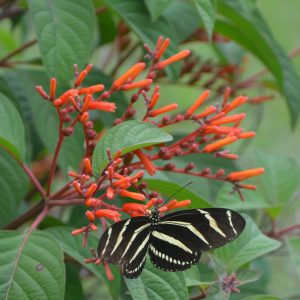
By Les Harrison
Wakulla County Extension Director
In the classic movie The Wizard of Oz, while clicking the heels of the emerald slippers Dorothy said, “There is no place like home.” In the minds of most this is a true sentiment, even if somewhat idealistic and a bit nostalgic.
At home everything is where it belongs with nothing out of place, alien, or strange. In the mind of the observer things have always been where they are and function in a familiar fashion, as intended by the grand design. In the study of botany this is the basis for the advantages of native plants.
Native plants, with an origin obscured by the mist of time, are species which were here before people arrived. In some cases there is a debate about certain species since they may have been temporarily overlooked by the initial wave of botanist and plant pathologist centuries ago.
Such is the case with one “Florida native” Hamelia patens which is commonly known locally as Mexican Firebush. The name aside, this species is found in its native range from Florida to Argentina and many places in between.
This plant is a delight to anyone who wishes to add its attractive and consistent orange-red blooms to a landscape during the warm seasons. It is a quick growing soft-stemmed shrub which reaches a height and width of 8 to 12 feet tall without external support.
Typically a one foot tall specimen planted in the spring has the potential to reach five feet or more by the following winter. Specimens can grow to 15 feet tall or more if provided the support of a trellis or other structure.
Its evergreen leaves are covered with red tomentum (hairs) when young and are speckled with red or purple at maturity. Also a distinctive red are the stalk which attaches the leaf to the stem and young stems.
Usually three leaves are arranged in whorls. Bright orange-red flowers project from the forking cluster of blooms at the tips of the branches much of the year in Wakulla County.
The petite, slender flowers are tubular and reach a length of an inch to an inch and a half. While this species is tolerant of shade, flowering is reduced when exposure to the sun is limited.
Birds, especially hummingbirds, are frequent visitor to the Mexican Firebush. Many insect pollinators, including butterflies, are attracted to the nectar available from the numerous bright flowers.
Small rounded glossy black fruits are produced from the blooms. There is a continuous crop of these seedy fruit during the late spring through autumn, and a variety of birds are quite fond of them.
For the home landscaper, the Mexican Firebush can be used as a foundation plant for large structures and is superb when placed in the background of a mass of shrubs in a border to naturalize the setting.
Its dense foliage makes this plant well suited as a screen or establishing a border. A hedge of this shrub will need regular clipping and pruning, with flowers typically removed during this process.
Whether or not it deserves the native classification is because this species is found growing naturally in a variety of situations in the central Florida location of Sumter County and points south. Either way, it grows well in well in Wakulla County.
For the homeowner with less than ideal horticultural skills, it is important to know it does not take a wizard or enchanted shoes to propagate this showy perennial.
For more information about growing Mexican Firebush inWakulla County, contact the UF/IFAS Wakulla County Extension Office at 850-926-3931 or https://blogs.ifas.ufl.edu/wakullaco/.
 0
0


